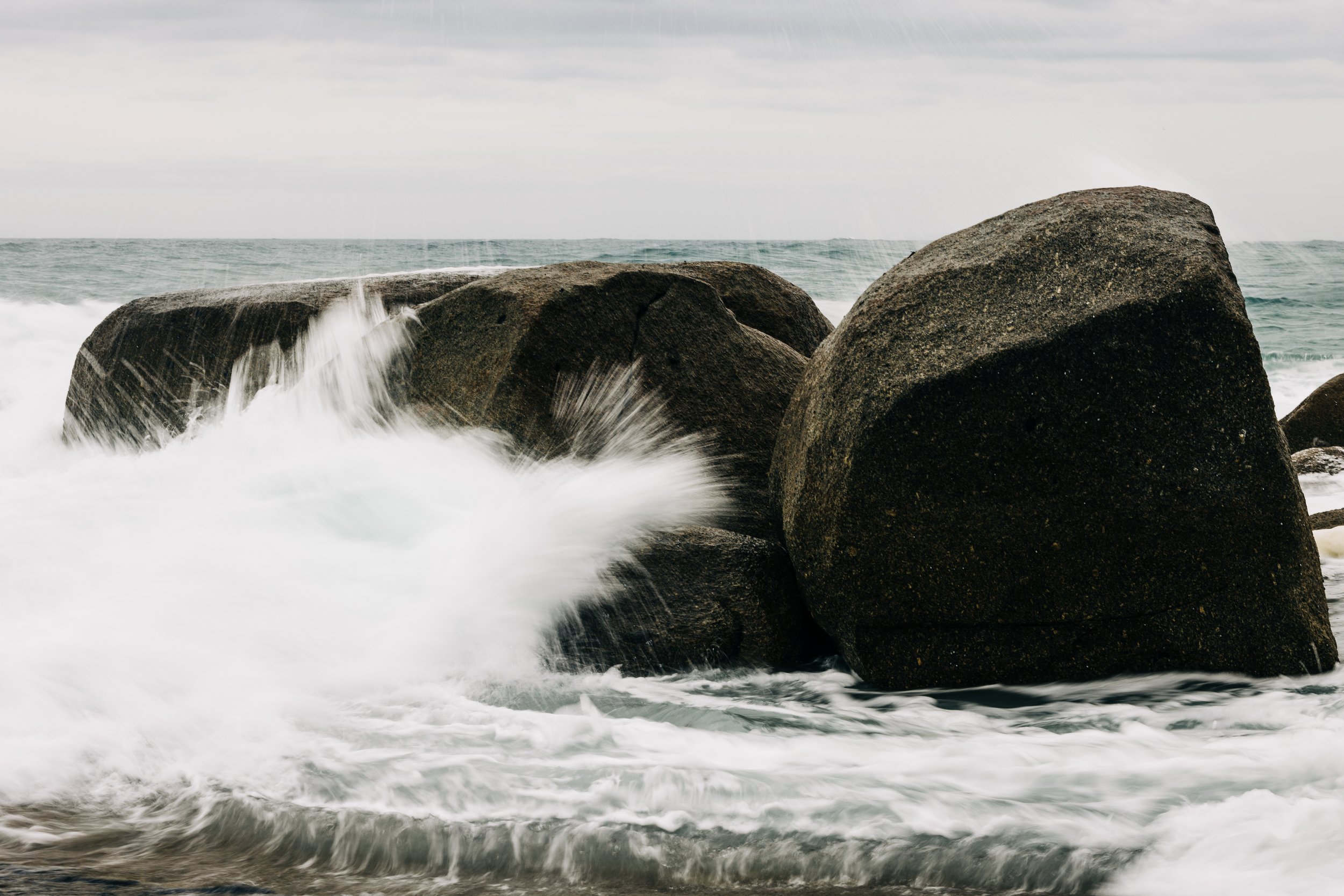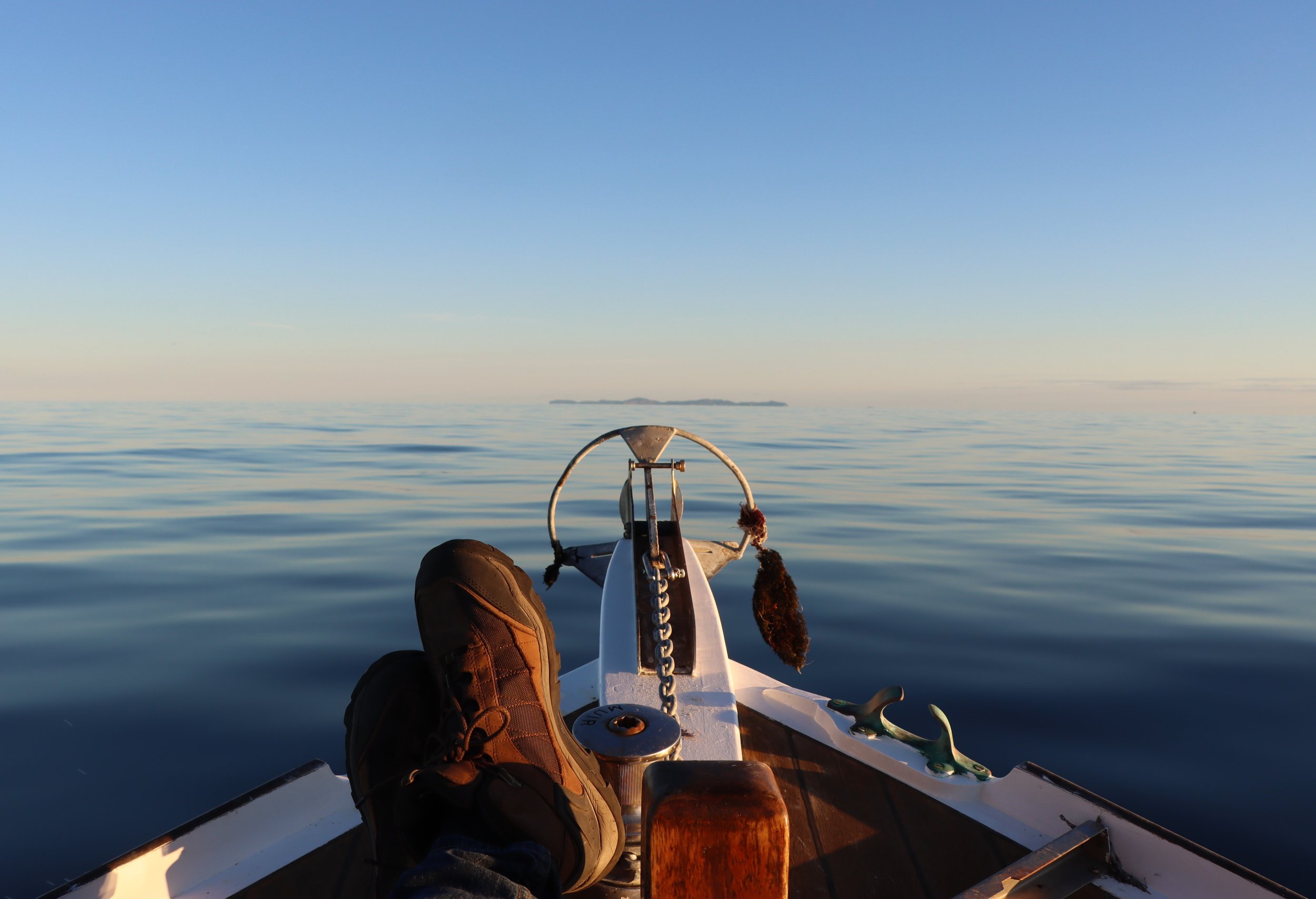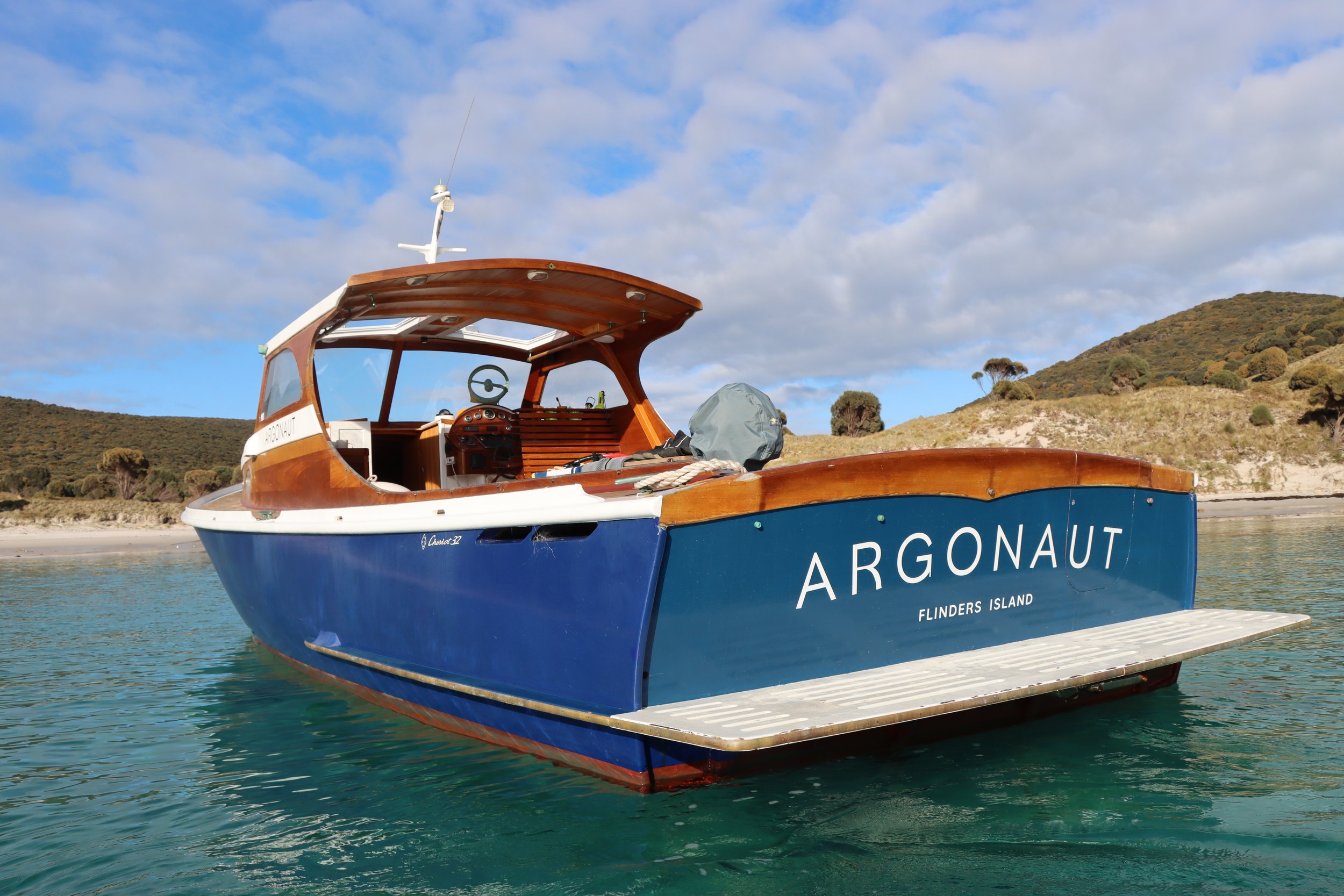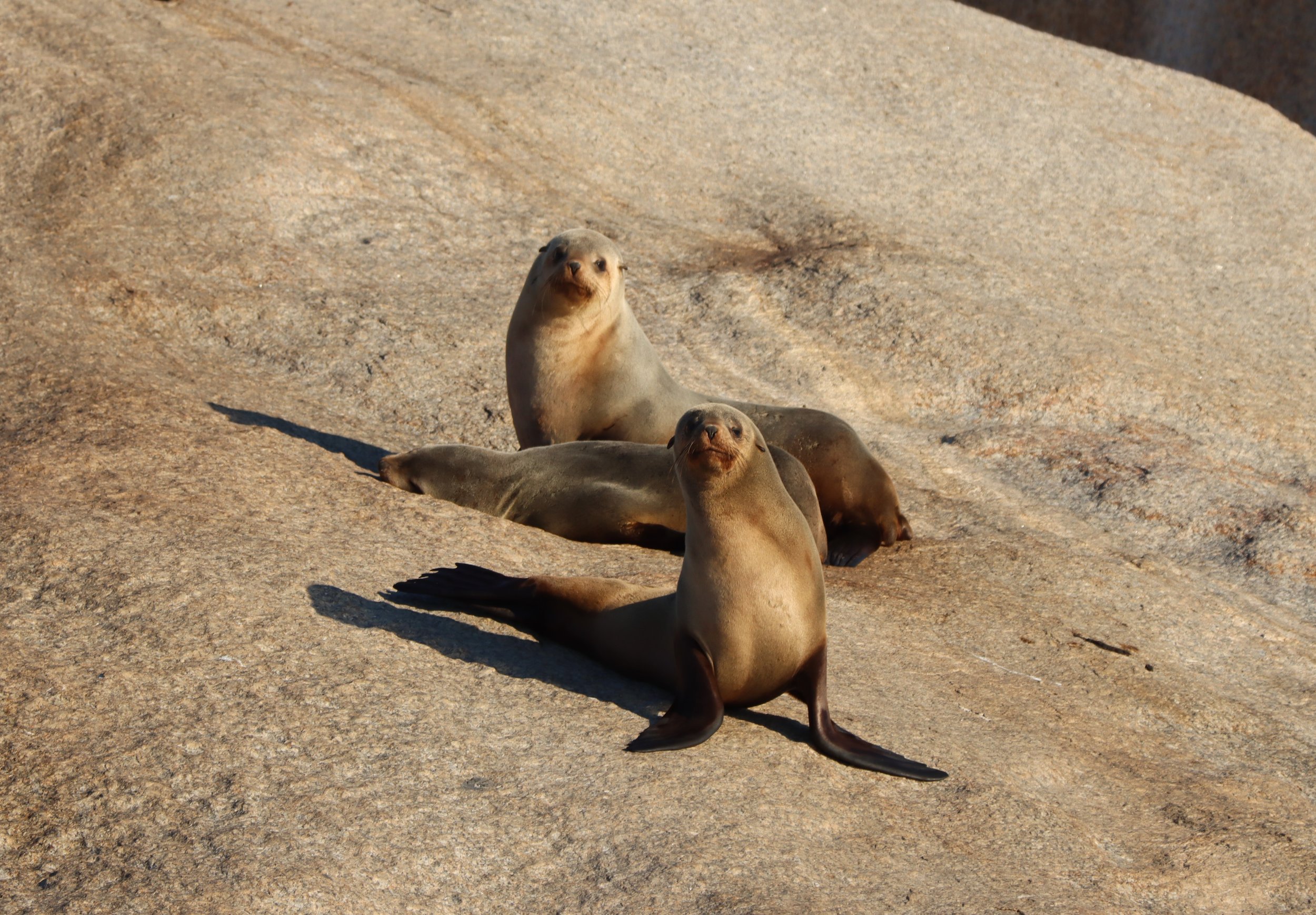
THE VOYAGE OF THE ARGONAUT
WORDS AND IMAGES BY JOCK SERONG
Bass Strait is a window of shallow water between the Australian continent and its major southern satellite, Tasmania. The Strait has frustrated and flummoxed humans since time immemorial. Aboriginal people found that it came and went with the ice ages over millennia, leaving behind a flat grassy plain when the seas fell, and stranding the mountains in its eastern and western margins as islands when the seas rose. For early European explorers and traders, the true nature of this body of water was never quite clear – was it a river estuary? A large bay? – until the wrecking of the Sydney Cove in 1797 put the matter to rest, inspiring George Bass to voyage deep into eastern Bass Strait and solve the riddle.
And just as the Strait appears and disappears, so too do the opportunities to cross it. It all hinges upon windows in the weather; most often in autumn when the summer easterlies have blown out and winter’s big south-westerly fronts are yet to materialise. Even a modest breeze across these shallow and refractive waters can make the crossing a misery.
So it was that we planned the delivery of the Argonaut, from Furneaux Distillery’s Flinders Island home northwest to Melbourne, for a one-week window in May. The odds seemed good that we’d find ourselves on tolerable seas.
As it happened, the conditions were freakishly perfect.
Straight off the buzzing-insect flight, slam the car doors and throw open the shed door: Furneaux Distillery’s bond store among the eucalypts at Sawyers Bay. Time was of the essence: there was a boat to load, the uncovering and un-mooring and the voyage up Flinders Island’s west coast to safe anchorage before anyone would get a look at a beer, let alone a world-class Tasmanian whisky.
But Furneaux’s co-founders Damien and Howie, and head distiller Tom didn’t seem to feel the urgency. There was no memo about caps and flannies. Not all of us had packed right.
The Argonaut’s mooring off Blue Rocks at Flinders Island is a story in itself: a feat of bush engineering for the ages. But even this unshakeable base is unsuited to wintering, so the Argonaut was headed north to hibernate.
A ruffling breeze threatened as Damien hauled on the mooring line, but this was as windy as the voyage ever got.
At anchor off Roydon Island, a deep chill descended off the land: something other than the cold that comes of a stripping wind at sea. There were awnings in secret compartments, a fitting and a clip and a pole and a curious knot for every contingency.
Below us, a huge dark ray hovered patiently in mid-water, waiting for a thrown scrap of food. The big ones seem to have a memory for wins of this kind: for how many decades had the old animal watched the undersides of anchoring vessels, recalling abundance?
The west coast of Flinders Island is guarded by countless islets and uncharted boulders. Motoring west from there at dawn is a perilous business: great granite domes lurk just beneath the surface, and many of them are garlanded in the splintered timbers of their victims.
We left behind the craggy peaks of Mt Killiecrankie and Roydon Island, where a straggle of conservation volunteers in bright hi-vis watched us pass. Coffee is rarely as good as it was for this dawn: a brave little Bialetti skittering on the gas jet until it burbled up three cups worth of gold.
The Argonaut’s small cockpit is a collection of clever deceptions. There are brass dials, a spoked wooden steering wheel and a traditional compass floating in spirit. The timber joinery is exquisite. But there’s also a touch-screen nav system that runs an autopilot and an array of data collectors that could precisely measure the depth of a passenger’s G&T on the aft deck.
Here’s Damien, assessing the need for another slice of lemon.
Although it’s hard to discern in the below image, the Argonaut is going flat out. How many days of the year could a lucky soul recline on the bow with a delicate camera and remain perfectly dry at 16 knots? And while we’re grappling with imponderables, on how many days in a lifetime can you see the curvature of the earth at the horizon?
The landmass in the distance is Deal Island, the literal and figurative crossroads of the eastern strait.
A bird is sometimes not so much a winged creature in flight, as a rune or a hieroglyphic. This image is taken many nautical miles between islands – one of the longest open stretches of water between the Victorian coast and the Furneaux Group.
But for a short-tailed shearwater the crossing is a mere stroll: this is a bird whose annual migration makes a giant loop from Bass Strait to Alaska, Russia and the Aleutian Islands and back across the Pacific, relying upon navigational instincts that are yet to be understood by science, and running on tiny increments of nutrition…and returning to precisely the same burrow that they left the previous season.
Damien presented his two-man crew with matching yellow beanies, in an approximate tribute to Cousteau and The Life Aquatic. A small adjustment of the headwear created the endearing garden gnome effect modelled here by Howie, paddling his way over the gin-clear waters of Garden Cove, Deal Island.
For there is nothing half so much worth doing as simply messing about in boats.
Studies have shown that the most common reason for photographing a boat is to sell the damn thing.
But not here, oh no. Drawing away from the stern of the Argonaut, the eye is captured by the graceful lines, the blue on teal on blue. It begs to be photographed, like a Labrador pup or a Melbourne influencer. The backdrop is so typical of the islands of the eastern Strait: low, tough scrub and dazzling white sand. A short walk from this anchorage there was an old light-keeper’s cottage, patrolled by shy wallabies and fat, honking Cape Barren Geese. There’s no sense of time, other than the ticking away of that window of perfect weather.
The Deal Island lighthouse, viewed from the light-keeper’s cottage. Quite a commute to work.
The rocky cliffs to the right of the lighthouse are granite, as are all of these islands, but they call to mind the columnar dolerite of the Tasman Peninsula, much further south. There’s a sinister feeling about these lighthouses – this one, Goose Island’s in the extreme southwest of the Furneaux, and the one on Tasman Island – that they were places of isolation and ultimately of madness for their keepers. Willem Dafoe and Robert Pattinson nailed the mood. Best visited in broad daylight.
The sloping boulders of Wilson’s Prom are home to colonies of New Zealand Fur Seals (in Maori, kekeno), one of the five endemic species of pinnipeds that 18th and 19th century sealers hunted nearly to extinction. Although their numbers are recovering, there are large parts of eastern Bass Strait where their haul-outs are still empty.
Skull Rock, just off the southern tip of Wilson’s promontory, is Victorian in its geography but Tasmanian in its Gothic splendour. The hollowed face of it, to the right of this image, glares into the setting sun above an abrupt seventy-metre plunge to the sea floor. At the left of the image, away in the distance, is Rodondo Island, a rock without a viable landing point where escaped convicts hid out from authorities and clawed a desperate living from the entrails of seabirds and the hard-won nourishment of intertidal molluscs. George Bass is said to have found seven of them on Rodondo in the late 1700s: they frightened him so much he threw them food and fled.
The wide, flat expanses of Port Phillip Bay still feel like a meadow on a calm day. Just three metres under the surface here, that’s what they are. After the drama of an early morning passage through The Rip, there’s a sense of anti-climax about the voyage up the shipping channel, but also a sense of home’s beckoning.
The West Channel Pile Light was built in 1881. The enclosed octagonal space is the light-keeper’s abode (see light-keepers and madness, above). These days, although still operation, it runs on solar power and not Robert Pattinson with a bucket of paraffin.
Jock Serong is an accomplished author with a deep connection to the Furneaux islands. His novels Preservation and The Burning Island tell gripping and evocative stories of the island's wild history, it's land and people.












